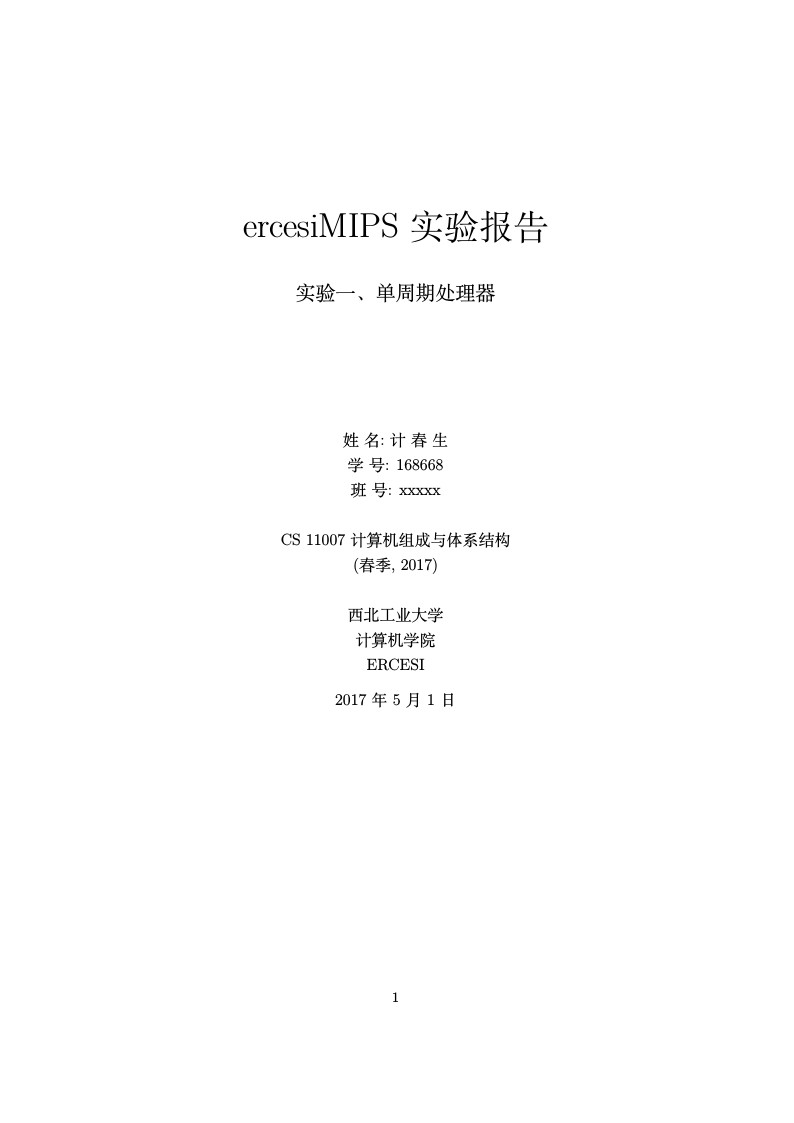
ercesiMIPS 实验报告模版
Auteur:
Meng Zhang
Last Updated:
il y a 9 ans
License:
Creative Commons CC BY 4.0
Résumé:
中文ercesiMIPS实验报告模版。 使用ctex包,xelatex进行编译。格式与英文版本一致。

\begin
Discover why over 20 million people worldwide trust Overleaf with their work.
中文ercesiMIPS实验报告模版。 使用ctex包,xelatex进行编译。格式与英文版本一致。

\begin
Discover why over 20 million people worldwide trust Overleaf with their work.
\documentclass[a4paper]{article}
\input{style/ch_xelatex.tex}
\input{style/scala.tex}
\lstset{frame=, basicstyle={\footnotesize\ttfamily}}
\graphicspath{ {images/} }
\usepackage{ctex}
%-----------------------------------------BEGIN DOC----------------------------------------
\begin{document}
\renewcommand{\contentsname}{目\ 录}
\renewcommand{\appendixname}{附录}
\renewcommand{\appendixpagename}{附录}
\renewcommand{\refname}{参考文献}
\renewcommand{\figurename}{图}
\renewcommand{\tablename}{表}
\renewcommand{\today}{\number\year 年 \number\month 月 \number\day 日}
\title{{\Huge ercesiMIPS 实验报告{\large\linebreak\\}}{\Large 实验一、单周期处理器\linebreak\linebreak}}
%please write your name, Student #, and Class # in Authors, student ID, and class # respectively
\author{\\姓\ 名:计\ 春\ 生\\
学\ 号: 168668\\
班\ 号: xxxxx\\\\
CS 11007 计算机组成与体系结构\\
(春季, 2017)\\\\
西北工业大学\\
计算机学院\\
ERCESI}
\date{\today}
\maketitle
\newpage
%-----------------------------------------ABSTRACT-------------------------------------
\begin{center}
{\Large\bf{摘\ 要\\}}
\end{center}
请在这里输入摘要内容.
\newpage
%-----------------------------------------ABSTRACT-------------------------------------
\begin{center}
{\Large\bf{版\ 权\ 声\ 明\\}}
\end{center}
该文件受《中华人名共和国著作权法》的保护。ERCESI实验室保留拒绝授权违法复制该文件的权利。任何收存和保管本文件各种版本的单位和个人,未经ERCESI实验室(西北工业大学)同意,不得将本文档转借他人,亦不得随意复制、抄录、拍照或以任何方式传播。 否则,引起有碍著作权之问题,将可能承担法律责任。\newpage
%-----------------------------------------CONTENT-------------------------------------
\begin{center}
\tableofcontents\label{c}
\end{center}
\newpage
%------------------------------------------TEXT--------------------------------------------
%----------------------------------------OVERVIEW-----------------------------------------
\section{概述} \label{overview}%------------------------------
这一节请主要描述组成原理课程(cs11007)中所介绍的单周期处理器的基本结构及工作机理。Latex中文添加了ctex包,请使用xelatex编译该文件,即在对应文件夹命令行输出,xelatex ReportTemp\_ch\_xelatex.tex
可使用分列项目(itemize)的方法说明不同的属性介绍。例如:
\begin{itemize}
\item{\textbf{处理器支持的指令} 包括: \emph{sub, add, or, ori, lw, sw, lst, beq, j}。}
\item{\textbf{所有指令在一个周期内完成} 在目前阶段,单周期处理器模型讲计算、控制通路分开设计,为理解处理器结构提供了良好的支持。}
\item{\textbf{本设计包含处理器数据通路、控制逻辑以及存储结构} 为了说明计算机系统结构的特点,我们推荐奖处理器的数据通路、控制通路分开设计。}
\item{\textbf{使用Chisel3描述结构} Chisel是一种强大的结构化硬件描述语言,可以对模块、接口以及操作等进行高效率的描述,与Verilog语言相比较,对电路的结构属性具有更好的封装,对系统的描述更加简化。我们选择Chisel3是因为在Linux系统中,使用Chisel3完全不再依赖工业EDA软件实现电路的逻辑仿真,更有利于学术研究和教学应用。虽然Chisel语法在不同版本差异不大,但是部分修饰符的描述方式仍然具有差别,详细区别请参考: \url{https://github.com/ucb-bar/chisel3/wiki/Chisel3-vs-Chisel2}.}
\end{itemize}
%----------------------------------SYSTEM DESIGN------------------------------------------
\newpage
\section{系统设计} \label{sysdes}%------------------------------
\subsection{System Overview}\label{sub:sysover}
请在这一节描述单周期处理器的系统设计。推荐使用图表进行说明的方法,Latex中插入图并进行索引的方式如下:图\ref{fig:singleblock}.
\begin{figure}[ht]
\centering
\includegraphics[height=5cm]{images/l1sys.pdf}
\caption{单周期处理器结构图}
\label{fig:singleblock}
\end{figure}
如果需要索引参考文献,请使用\cite{Erdos01}, 同时已经将参考文献的项目模版在文末写出。
\subsection{接口定义}\label{sub:Interface}
请详细描述系统顶层接口信号的名称、逻辑特征、时许特性。可以建立类似表\ref{tab:signaldef}这样的列表进行说明。
\begin{table}[htp]
\caption{测试模式信号定义}\label{tab:signaldef}
\begin{center}
\begin{tabular}{|l|l|l|p{6cm}|}
\hline
\textbf{信号名} & \textbf{方向} & \textbf{位宽} & \textbf{功能描述}\\ \hline \hline
boot & Input & 1-bit & 触发测试模式, 当处理器正常工作时被置为0\\ \hline
test\_im\_wr & Input & 1-bit & Instruction memory write enable in test mode,set to 0 in
CPU regular process mode. In test mode, it will be set to 1 when if writing instructions to imem, otherwise it is set to 0.\\ \hline
test\_im\_re & Input & 1-bit & Instruction memory read enable in test mode,set to 0 in
CPU regular process mode. In test mode, it will be set to 1 when if reading instructions out, otherwise it is set to 0. \\ \hline
test\_im\_addr & Input & 32-bit& Instruction memory address\\ \hline
test\_im\_in & Input & 32-bit& Instruction memory data input for test mode. \\ \hline
test\_im\_out & Output& 32-bit& Instruction memory data output for test mode. \\ \hline
test\_dm\_wr & Input & 1-bit & Data memory write enable in test mode,set to 0 in
CPU regular process mode. In test mode, it will be set to 1 when if writing data to dmem, otherwise it is set to 0.\\ \hline
test\_dm\_re & Input & 1-bit & Data memory read enable in test mode,set to 0 in
CPU regular process mode. In test mode, it will be set to 1 when if reading data out, otherwise it is set to 0.\\ \hline
test\_dm\_addr & Input & 32-bit& Data memory address\\ \hline
test\_dm\_in & Input & 32-bit& Data memory input for test mode. \\ \hline
test\_dm\_out & Output& 32-bit& Data memory output for test mode. \\ \hline
valid & Output& 1-bit & If CPU stopped or any exception happens, valid signal is set to 0.\\
\hline
\end{tabular}
\end{center}
\end{table}
\subsection{接口的(时许)逻辑}\label{sub:logicinter}
请在这个小节描述顶层结构中接口信号使用的逻辑、时序关系等。同样请利用图、表的方法进行描述。特别是时序,请画出时许图。
% -----------------------------------BLOCKS DESIGN----------------------------------------
\section{模块详细设计}
这一节,主要描述各个模块的功能、接口、逻辑控制方法(状态机控制方法)等。
\subsection{ALU}\label{sub:alu}
\subsubsection{功能描述}
\subsubsection{接口定义}
\subsubsection{逻辑控制}
\subsection{控制模块}\label{sub:ctl}
\subsubsection{功能描述}
\subsubsection{接口定义}
\subsubsection{逻辑控制}
\subsection{数据通路}\label{sub:dat}
\subsubsection{功能描述}
\subsubsection{接口定义}
\subsubsection{逻辑控制}
%add more subsections for other block in you CPU design.
\section{实验过程记录}\label{labrec}
记录实验的过程,完成了什么样的工作,存在的问题包括哪些,解决方案如何等。subsubsection名称自行设定。
% -----------------------------------Appendix----------------------------------------
\appendix
\section{代码}\label{sub:app.code}
请在附录\ref{sub:app.code}中添加代码。请使用如下Scala的语法高亮描述方法。
\begin{scala}
class TopIO extends Bundle() {
val boot = Input(Bool())
// imem and dmem interface for Tests
val test_im_wr = Input(Bool())
val test_im_rd = Input(Bool())
val test_im_addr = Input(UInt(32.W))
val test_im_in = Input(UInt(32.W))
val test_im_out = Output(UInt(32.W))
val test_dm_wr = Input(Bool())
val test_dm_rd = Input(Bool())
val test_dm_addr = Input(UInt(32.W))
val test_dm_in = Input(UInt(32.W))
val test_dm_out = Output(UInt(32.W))
val valid = Output(Bool())
}
class Top extends Module() {
val io = IO(new TopIO())//in chisel3, io must be wrapped in IO(...)
//...
when (io.boot & io.test_im_wr){
imm(io.test_im_addr) := io.test_im_in
} .elsewhen (io.boot & io.test_dm_wr){
// please finish it
} //...
}
\end{scala}
\newpage
% -----------------------------------REFERENCE----------------------------------------
\begin{thebibliography}{9}
\bibitem{Erdos01} P. Erd\H os, \emph{A selection of problems and
results in combinatorics}, Recent trends in combinatorics (Matrahaza,
1995), Cambridge Univ. Press, Cambridge, 2001, pp. 1--6.
\end{thebibliography}
\end{document}